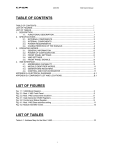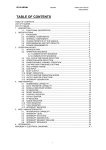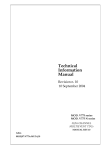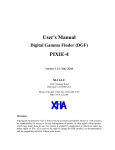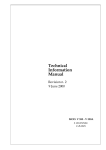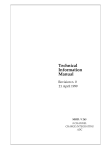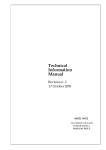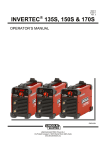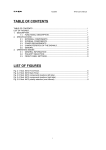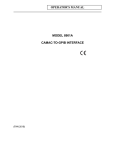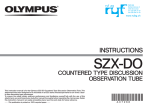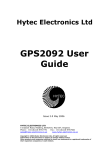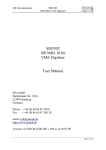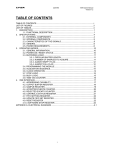Download CAEN V556 rev0
Transcript
04/03/96
V556 User's Manual
TABLE OF CONTENTS
TABLE OF CONTENTS ....................................................................................................... i
LIST OF FIGURES.............................................................................................................. ii
LIST OF TABLES................................................................................................................ ii
1. DESCRIPTION.............................................................................................................. 1
1.1. FUNCTIONAL DESCRIPTION.......................................................................... 1
2. SPECIFICATIONS......................................................................................................... 4
2.1. PACKAGING................................................................................................. 4
2.2. EXTERNAL COMPONENTS............................................................................ 4
2.3. INTERNAL COMPONENTS............................................................................. 4
2.4. CHARACTERISTICS OF THE SIGNALS........................................................... 5
2.5. PERFORMANCES AND TEST RESULTS ........................................................ 5
2.6. POWER REQUIREMENTS ............................................................................. 5
3. OPERATING MODES ................................................................................................... 8
3.1. GENERAL INFORMATION.............................................................................. 8
3.2. OPERATION SEQUENCE .............................................................................. 8
3.3. ENABLE/DISABLE CHANNEL OPERATION .................................................... 9
3.4. LOW AND HIGH THRESHOLD SETTING ......................................................... 9
3.5. ADC DYNAMIC RANGE ................................................................................. 10
3.6. GATE INPUT................................................................................................. 10
3.7. BUSY OUTPUT ............................................................................................. 10
3.8. RESET/FAST CLEAR INPUT.......................................................................... 11
3.9. OUTPUT BUFFER UTILIZATION...................................................................... 11
3.10. OUTPUT BUFFER STRUCTURE ..................................................................... 12
3.11. INTERRUPT GENERATION ............................................................................ 13
4. VME INTERFACE ......................................................................................................... 14
4.1. ADDRESSING CAPABILITY ........................................................................... 14
4.2. DATA TRANSFER CAPABILITY ...................................................................... 14
4.3. MODULE IDENTIFIER WORDS....................................................................... 16
4.4. HF REGISTER............................................................................................... 17
4.5. RESET REGISTER........................................................................................ 17
4.6. CONTROL REGISTER.................................................................................... 18
4.7. OUTPUT BUFFER ......................................................................................... 19
4.8. FF REGISTER............................................................................................... 20
4.9. DELAY REGISTER........................................................................................ 20
4.10. THRH REGISTER .......................................................................................... 22
4.11. THRL REGISTER........................................................................................... 22
4.12. INTERRUPT REGISTER................................................................................. 23
5. MOD. V556 INTERRUPTER........................................................................................... 24
5.1. INTERRUPTER CAPABILITY .......................................................................... 24
5.2. INTERRUPT LEVEL....................................................................................... 24
5.3. INTERRUPT STATUS/ID................................................................................. 24
5.4. INTERRUPT GENERATION ............................................................................ 24
5.5. INTERRUPT REQUEST RELEASE.................................................................. 24
5.6. INTERRUPT SEQUENCE ............................................................................... 25
6. REFERENCES............................................................................................................. 26
i
04/03/96
V556 User's Manual
LIST OF FIGURES
Fig. 1.1: Mod. V556 Block Diagram ...................................................................................... 3
Fig. 2.1: Mod. V556 Front Panel........................................................................................... 6
Fig. 2.2: Mod. V556 Components Locations .......................................................................... 7
Fig. 3.1: Mod. V556 Acquisition Sequence............................................................................ 9
Fig. 3.2: Mod. V556 Output Buffer data packet FIFO Structure................................................ 12
Fig. 4.1: Mod. V556 Base Address Setting............................................................................ 15
Fig. 4.2: Module Identifier Words .......................................................................................... 16
Fig. 4.3: Mod. V556 Control Register .................................................................................... 18
Fig. 4.4: Output Buffer Data Packet Header........................................................................... 19
Fig. 4.5: Mod. V556 Output Buffer Channel Data.................................................................... 19
Fig. 4.6: Mod. V556 Output Buffer Data Packet FIFO Structure............................................... 20
Fig. 4.8: Mod. V556 Delay Register ...................................................................................... 21
Fig. 4.9: Mod. V556 THRH Register...................................................................................... 22
Fig. 4.10: Mod. V556 THRL Register..................................................................................... 22
Fig. 4.11: Mod. V556 Interrupt Register................................................................................. 23
LIST OF TABLES
Table 4.1: Address Map for the Mod. V556............................................................................ 16
ii
04/03/96
V556 User's Manual
1. DESCRIPTION
1.1.FUNCTIONAL DESCRIPTION
The Model V 556 is a 1-unit wide VME module that houses 8 Peak Sensing Analog to Digital
Conversion channels, able to detect and convert the peak value of the analog signals fed to the
relevant connectors.
The basic structure of the circuit is a multistretcher configuration. For each channel the
relevant stretcher detects the peak value of the input signal during the time interval in which a
GATE input signal is TRUE. The channels can accept input pulses with a dynamic range from
0 V to 4.096 V.
The outputs of the eight stretcher sections are multiplexed and subsequently converted by a
fast 12 bit ADC module (1 µsec conversion time). The ADC module adopts a sliding scale
technique to improve the differential linearity.
The board houses a 12 bit counter (Event Counter) for the trigger counting; it is increased
whenever a pulse is sent to the GATE input.
Via VME it is possible to enable /disable each channel, to set a Low and a High Threshold for
the Zero Suppression and to program a delay between the end of the GATE and the Start of
the conversion.
Only the enabled channels are converted; if the value lies in between the Low and the High
Threshold the result is stored in an Output Buffer that can be read via VME.
The Output Buffer is arranged in a FIFO logic 512 x16 bit.
The module houses a VME RORA INTERRUPTER: via VME it is possible to program the
interrupt generation on the Output Buffer HALF FULL or on the Output Buffer NOT EMPTY.
A front panel LED (DTACK) lights up each time the module generates the VME signal DTACK.
An open-collector signal ("BUSY") is available on the front panel. This allows to obtain a wiredOR Global Busy signal. The BUSY is a high impedance output and is provided with two
bridged connectors for daisy chaining.
The V556 Model uses the P1 and P2 connectors of VME and the auxiliary connector for the
CERN V430 VMEbus crate (Jaux Dataway).
The module works in A24/A32 mode; the recognized Address Modifier codes are:
AM= %3D standard supervisor data access;
AM= %39 standard user data access;
AM= %0D extended supervisor data access;
AM= %09 extended user data access.
1
04/03/96
V556 User's Manual
The module's Base Address is fixed by 6 internal rotary switches housed on two piggy-back
boards plugged into the main printed circuit board. The Base Address can be selected in the
range:
%00 0000
<-> %FF FF00
A24 mode;
%0000 0000 <-> %FFFF FF00 A32 mode.
The data transfer occurs in D16 mode.
2
04/03/96
V556 User's Manual
IDENTIFIER
IN
INPUT 0
PEAK
DETECTOR
GATE
VME
IN
INPUT 1
PEAK
DETECTOR
INTERFACE
GATE
IN
INPUT 2
PEAK
DETECTOR
GATE
IN
INPUT 3
PEAK
DETECTOR
GATE
MUX
OUTPUT
ADC
BUFFER
IN
INPUT 4
PEAK
DETECTOR
GATE
IN
INPUT 5
PEAK
DETECTOR
GATE
IN
INPUT 6
CONTROL LOGIC
PEAK
DETECTOR
GATE
IN
INPUT 7
PEAK
DETECTOR
IRQ
INTERRUPTER
GATE
INT. LEVEL
STATUS /ID
GATE
BUSY
RST (or FAST CLEAR)
Fig. 1.1: Mod. V556 Block Diagram
3
04/03/96
V556 User's Manual
2. SPECIFICATIONS
2.1.PACKAGING
1-unit wide VME unit. Height: 6U.
2.2.EXTERNAL COMPONENTS
(Refer to fig. 2.1)
CONNECTORS
- No.8, "IN 0..7", input connectors, LEMO 00 type; for the 8 single channel inputs.
- No.2, "GATE", input connectors, LEMO 00 type; two bridged connectors (for daisy chaining)
for the GATE input signals.
- No.2, "RST", input connectors, LEMO 00 type; two bridged connectors (for daisy chaining) for
the RST input signals.
- No.2, "BUSY", output connectors, LEMO 00 type; two bridged connectors (for daisy
chaining) for the BUSY output signal .
DISPLAYS
- No.1, "DTACK", green LED, VME Selected; it lights up during a VME access.
2.3.INTERNAL COMPONENTS
(Refer to fig. 2.2)
SWITCHES
- No.6, rotary switches for the module VME Base address selection.
4
04/03/96
V556 User's Manual
2.4.CHARACTERISTICS OF THE SIGNALS
- INPUT CHANNELS: positive polarity, DC coupled, 1 KΩ impedance;
Shape: square wave or semigaussian pulses with risetime > 100 ns;
Input range: 0 to 4096 mV (0.15 to 3.75 V suggested).
- GATE (1):
Std. NIM level, high impedance;
min. width 200 ns.
- RST(1):
Std. NIM level, high impedance;
min. width 10 ns.
- BUSY:
Std. TTL open collector output (active high)
(1) This is a high impedance input and is provided with two bridged connectors for daisy chaining. Note
that the high impedance makes this input sensitive to noise, so the chain has to be terminated on 50 Ω on
the last module; the same is needed also if one module only is used, whose input has thus to be properly
matched.
2.5.PERFORMANCES AND TEST RESULTS
Differential non linearity
± 2% (between 10% and
90% of the range)
Integral non linearity
± 0.1%
Conversion time (2)
Minimum
3 µs
Maximum
13 µs
(2) This is the time spent in the entire conversion sequence (see § 3.2); the minimum value is obtained when all
the 8 values are not in the range selected and hence there is no ADC conversions, Substantially it is the Control
Logic scan time. The max. value is obtained when all the 8 values are in the range selected and therefore
converted and stored in the output buffer.
2.6.POWER REQUIREMENTS
+ 12 V
− 12 V
+5V
−5V
500 mA
100 mA
1.3 A
500 mA
5
04/03/96
V556 User's Manual
Mod. V560E
Mod. V556
IN
7
6
5
4
Inputs 0..7
3
2
1
0
G
A
T
E
GATE input
RESET/FAST CLEAR input
R
S
T
D
T
A
C
K
BUSY output
B
U
S
Y
16 CH
SCALER
8 CH PEAK
SENSING
ADC
Fig. 2.1: Mod. V556 Front Panel
6
VME selected LED
04/03/96
V556 User's Manual
VME P1 connector
Rotary switches
for Base address selection
Paux connector
for CERN VMEbus
crate type V430
VME P2 connector
Component side of the board
Fig. 2.2: Mod. V556 Components Locations
7
04/03/96
V556 User's Manual
3. OPERATING MODES
3.1.GENERAL INFORMATION
The module V556 houses 8 Peak Detection channels. The Peak Detection outputs are
multiplexed and subsequently converted by a high speed ADC module. A Control Logic
controls the conversion sequence; it converts and stores in the Output Buffer only the channels
that have values lying in a range between a High and a Low Threshold.
When the module is Busy it sets to TTL logic level "1" the Busy output. Moreover each
channel can be individually inhibited via VME.
The module is Busy during the conversion sequence, and when the Output Buffer is not ready
to accept data (Buffer full).
3.2.OPERATION SEQUENCE
If the module is not Busy and at least one channel is enabled, the leading edge of a NIM pulse
on the GATE input:
•
starts the Peak Detection on the enabled channels;
The trailing edge of the GATE signal stops the corresponding Peak Detection section and sets
the BUSY output to 1 (Module Busy). It is possible to program a delay up to 8 µs between the
end of the GATE and the Start of conversion via the Delay Register. When the programmed
Delay time is over, the Control Logic starts the conversion sequence:
•
the output of all the Peak Detection sections are sampled;
•
the Control Logic checks if the sampled value are in the selected range;
•
If at least one value is lying in the range:
•
•
a header is stored in the output buffer; it contains the event counter value and
the number of the channels in the range;
the sampled values in the range are converted and the 12 bit values obtained
are stored in the Output Buffer together with the corresponding channel number.
•
if no value falls in the range, no channel is converted and no data is written in the Output
Buffer.
•
increments the Event Counter;
•
The Busy is removed and the module is ready for the next acquisition.
Figure 3.1 summarizes the operation sequence here described.
8
04/03/96
V556 User's Manual
Prog. Delay
Conversion Time
Gate Width
GATE
BUSY
Event Counter
m
Start
Peak
Det.
m+1
Start conv.
sequence
Stop
Peak
Det.
End conv.
sequence
Fig. 3.1: Mod. V556 Acquisition Sequence
3.3.ENABLE/DISABLE CHANNEL OPERATION
Via VME It is possible to enable/disable the Peak Detection section of each channel; The bit
<7..0> of the Control Register controls the status of the 8 Peak Detection sections:
•
•
Control Register <n> = 0 → channel n Peak Detection disabled;
Control Register <n> = 1 → channel n Peak Detection enabled.
The Control Register is available at the VME address Base + %1A.
All the Peak Detection sections are disabled (Control Register <7..0> cleared) in the following
cases:
•
•
•
by accessing via VME the address Base + %1C (Reset Register);
by generating the VME signal SYSRES;
at Power-On.
3.4.LOW AND HIGH THRESHOLD SETTING
The Control Logic converts only the channels that have values lying in a range between a High
and Low Threshold.
The threshold values are 8 bit wide and are programmable via VME by a write access in two
write-only registers:
•
•
Low Threshold Register (THRL reg.)
High Threshold Register (THRH reg.)
VME address = Base + %10;
VME address = Base + %12.
9
04/03/96
V556 User's Manual
3.5.ADC DYNAMIC RANGE
The sliding scale correction reduces slightly the dynamic range of the ADC; the 12 bit digital
output is valid from 0 to 3840; values from 3841 to 4095 are not correct.
The usable range of the analog input of the ADC is ≈ 0.15 V..3.75 V. The conversion of an
analog input that is greater than the upper limit could lead to an unpredictable digital output
coding in the range from 0 to 255. The User should use the high threshold to maintain the
analog input of the ADC under this upper limit.
The recommended High Threshold values are less then %C7 (hex).
3.6.GATE INPUT
If the module is not BUSY, the leading edge of a NIM pulse on the GATE input (trigger):
•
starts the Peak value conversion of the enabled channels;
The trailing edge of a NIM pulse on the GATE input (trigger):
•
stops the Peak value conversion of the enabled channels;
•
sets the BUSY output to 1 (Module Busy);
•
increments the Event Counter.
This is a high impedance input and is provided with two bridged connectors for daisy chaining;
this allows to control easily a system of many units.
Note that the high impedance makes this input sensitive to noise, so the chain has to be
terminated on 50 Ω on the last module; the same is needed also if one module only is used,
whose inputs have thus to be properly matched.
3.7.BUSY OUTPUT
An open-collector signal ("BUSY") is available on the front panel. This is a high impedance
output and is provided with two bridged connectors for daisy chaining; this allows to obtain a
wired-OR Global Busy signal of a system of many units.
Each module sets to 1 its Busy output after the trailing edge of a pulse on the GATE input
(Module Busy) and releases it to 0 at the end of the conversion sequence. When the Module is
Busy it does not accept another GATE pulse.
If many units are connected in daisy chain mode via the GATE and BUSY signal, after a pulse
on the GATE input (trigger) the Global Busy signal is set to 1 and it is released to 0 only when
all the V556 modules in the chain have completed the conversion sequence and the entire
system is ready to accept another trigger.
10
04/03/96
V556 User's Manual
This avoids that some modules in the chain accept another trigger while other modules are still
Busy. This could cause a lack of coherence in the overall data (the event counter value of
different modules could not be coherent).
3.8.RESET/FAST CLEAR INPUT
It is possible to program the the function of this input via the bit<15> of the Control register (FC
bit)
•
Control register <15> = 0
RESET;
•
Control register <15> = 1
FAST CLEAR.
If the RST INPUT works as a RESET (FC bit in in Control Register set to 0), a pulse sets the
board in the following state:
1.
2.
3.
4.
5.
6.
7.
the event counter is set to 0;
the output buffer is reset (FIFO EMPTY);
all the channels are disabled (Control Register <7..0> cleared);
the delay is set to 0.
the Output Buffer is set to the HF mode.
the Interrupt start condition is set to 0 (Interrupt on buffer Half Full).
the Interrupt level is set to 0.
After a reset the module must be initialized again.
The VME Reset (access to address Base + %1E) and the generation of the VME signal
SYSRES perform the same actions; moreover these operations set to 0 the FC bit.
If the RST input works as a FAST CLEAR (FC bit in in Control Register set to 1), a pulse
generated after the end of the gate (within the window set with the delay register) aborts the
conversion (The event counter is not incremented).
3.9.OUTPUT BUFFER UTILIZATION
The output buffer is arranged in FIFO logic 512 x16 bit .
Two utilization mode are programmable via VME :
HF (Half Full) mode: The Module does not accept any trigger (Module BUSY) when the
number of data stored is greater than the half size of the FIFO.
FF (FIFO Full) mode: The Module does not accept any trigger (Module BUSY) when the FIFO
is full. In this operating mode it is possible to utilize all the memory location, but it is possible
to lose some data (If the FIFO becomes full during a conversion sequence).
11
04/03/96
V556 User's Manual
3.10. OUTPUT BUFFER STRUCTURE
During the conversion sequence, if at least one Peak Detection output value is lying in the
range identified by the High and Low Thresholds, the Control Logic stores in the output buffer
the following words:
•
a header that contains the event counter value and the number of the channels in the
range; this number also indicates the number of subsequent words in the FIFO related
to that event.
the 12 bit converted Peak values together with the corresponding channel number.
•
If no channel is in the correct range the Output Buffer is not written.
The Output Buffer is available at VME address BASE + % 18.
The bit 15 of the Output Buffer indicates if the word read is a header or a channel data:
•
•
Output Buffer <15> =1 → header
Output Buffer <15> =0 → channel data
The status of the Output Buffer is available in the Control Register:
•
•
•
Control Register <12> = 0 → Output Buffer is Half full;
Control Register <14> = 0 → Output Buffer is Empty.
Control Register <13> = 0 → Output Buffer is Full.
The following figure shows an example of the Output Buffer structure (see also fig. 4.4, 4.5):
•
•
•
•
The first datum written is HEADER 5;
In the Trigger n. 5 two channels (2 and 5) were in the selected range;
In the Trigger n. 6 and n. 7 no channel was in the selected range;
In the Trigger n. 8 three channels (0, 1 and 3) were in the selected range.
15 14 13 12 11 10 9 8 7 6 5 4 3 2 1 0
Trigger nr.5
ch.2 and ch.5 converted
H E A D E R 5
Event cnt. = 5 Mult. = 1
D a t u m
c h a n n e l
2
D a t u m
c h a n n e l
5
H E A D E R 8
Trigger nr.8
ch.0,ch.1and ch.3 converted
trigger 6 and 7:
no channel converted
Event cnt. = 8 Mult. = 2
D a t u m
c h a n n e l
0
D a t u m
c h a n n e l
1
D a t u m
c h a n n e l
3
Fig. 3.2: Mod. V556 Output Buffer Data Packet FIFO Structure
12
04/03/96
V556 User's Manual
3.11. INTERRUPT GENERATION
The operations of the V556 VME INTERRUPTER are fully programmable; via VME it is
possible:
•
to set the VME interrupt level;
•
to program the VME interrupt vector (STATUS/ID);
•
to program the interrupt generation on the Output Buffer HALF FULL or on the Output
Buffer NOT EMPTY; this is controlled by the bit 2 of the Interrupt Register:
•
Interrupt Register <12> = 0 → Interrupt on Output Buffer HALF FULL;
•
Interrupt Register <12> = 1 → Interrupt on Output Buffer NOT EMPTY.
13
04/03/96
V556 User's Manual
4. VME INTERFACE
4.1.ADDRESSING CAPABILITY
The module works in A32/A24 mode. This means that the module address must be specified
in a field of 32 or 24 bits. The Address Modifiers code recognized by the module are:
AM=%39
AM=%3D
AM=%09
AM=%0D
standard user data access
standard supervisor data access
extended user data access
extended supervisor program access
The module's Base Address is fixed by 6 internal rotary switches housed on two piggy-back
boards plugged into the main printed circuit board.
The Base Address can be selected in the range:
% 00 0000 <--> % FF FF00
A24 mode;
% 0000 0000 <->% FFFF FF00 A32 mode.
The Base Address reserves in this way a page of 256 bytes for the module. The Address Map
of the V556 module is shown in Table 4.1.
4.2.DATA TRANSFER CAPABILITY
The internal registers and the Output Buffer are accessible in D16 mode.
14
04/03/96
Base address bit <23..20>
Base address bit <19..16>
Base address bit <15..12>
Base address bit <11..8>
Base address bit <31..28>
Base address bit <27..24>
Fig. 4.1: Mod. V556 Base Address Setting
15
V556 User's Manual
04/03/96
V556 User's Manual
Table 4.1: Address Map for the Mod. V556
ADDRESS
REGISTER/CONTENT
TYPE
Base + %FE
Base + %FC
Base + %FA
Version & Series
Manufacturer & module type
Fixed code
read only
read only
read only
Base + %F8
.
.
Base + %1E
Not used
.
.
HF Register
read/write
Base + %1C
Base + %1A
Base + %18
Base + %16
Base + %14
Base + %12
Base + %10
Reset Register
Control Register
Output Buffer
FF Register
Delay Register
THRH Register
THRL Register
read/write
read/write
read only
read/write
read/write
write only
write only
Base + %0E
.
.
Base + %02
Not used
Base + %00
Interrupt Register
Not used
read/write
4.3.MODULE IDENTIFIER WORDS
(Base address + %FA ,+%FC, +%FE read only)
The Three words located at the highest address on the page are used to identify the module as
shown in figure 4.1:
15 14 13 12 11 10 9
V e r s i o n
F i x e d
7
M o d u l e ' s
Manufacturer number
% F A
8
6
5
s e r i a l
M o d u l e
c o d e
% F 5
4
3
2
1
n u m b e r
Address
Base + % FE
Base + % FC
t y p e
F i x e d
0
c o d e
Base + % FA
Fig. 4.2: Module Identifier Words
At the address Base + % FA the two particular bytes allow the automatic localization of the
module.
For the Mod. V556 the word at address Base + % FC has the following configuration:
Manufacturer N°=
Type of module =
000010 b
0000110110 b
16
04/03/96
V556 User's Manual
The word located at the address Base + %FE identifies the single module via the module's
serial number and any change in the hardware (for example the use of faster Conversion Logic)
will be shown by the Version number.
4.4.HF REGISTER
(Base address + %1E read/write)
A VME access (read or write) to this location set the Output Buffer in the HF mode:
the mode is available at the bit 12 of the Delay Register.
•
Delay Register <12>=0
HF mode;
•
Delay Register <12>=1
FF mode.
4.5.RESET REGISTER
(Base address + %1C read/write)
A VME access (read or write) to this location causes the following:
1.
2.
3.
4.
5.
6.
7.
8.
the event counter is set to 0;
the output buffer is reset (FIFO EMPTY);
all the channels are disabled (Control Register <7..0> cleared);
the delay is set to 0;
the Output Buffer is set to the HF mode;
the Interrupt start condition is set to 0 (Interrupt on buffer Half Full).
the Interrupt level is set to 0;
the FC bit is set to 0 (the RST input works as RESET).
The same action are performed if the VME signal SYSRES is active.
17
04/03/96
V556 User's Manual
4.6.CONTROL REGISTER
(Base address + %1A read/write)
15 14 13 12 11 10 9
FC
/FE
/FF
/HF
8
7
6
5
E7
E6 E5
4
3
2
1
0
E4
E3
E2 E1 E0
Enable ch. 0
Enable ch. 1
Enable ch. 2
Enable ch. 3
Enable ch. 4
Enable ch. 5
Enable ch. 6
Enable ch. 7
FIFO HALF FULL read only
FIFO FULL read only
FIFO EMPTY read only
FAST CLEAR SELECTION
Fig. 4.3: Mod. V556 Control Register
E<7..0>
Enable channel<7..0>:
=0
channel n Peak Detection disabled
=1
channel n Peak Detection enabled
These bits are cleared in the following cases:
by accessing via VME the address Base + %1C (Reset Register);
by generating the VME signal SYSRES;
at Power-On.
/HF
Output Buffer half full bit read only.
=0
Output Buffer is half full.
/FE
Output Buffer empty bit read only.
=0
Output Buffer is empty.
/FF
Output Buffer full bit read only.
=0
Output Buffer is full.
FC
Fast Clear selection
=0
A pulse in the RST input acts as a RESET of the module.
=1
A pulse in the RST input acts as a FAST CLEAR of the module.
(Bits 8 to 11, are unused and are read as "one" on the VME data bus).
18
04/03/96
V556 User's Manual
4.7.OUTPUT BUFFER
(Base address + %18 read only)
In this Buffer are available the data packets stored during the conversion sequence, if at least
one Peak Detection output value is lying in the selected range.
The first word of the packet is a header; it contains the event counter value and the number of
the channels in the range; this number also indicates the data packet length.
The other words contain the 12 bit converted Peak values together with the corresponding
channel number.
The bit 15 of the word distinguishes between header and channel data:
•
Output Buffer <15> =1 → header
•
Output Buffer <15> =0 → channel data
15 14 13 12 11 10 9
8
1
EVENT COUNTER
M U L T.
7
6
5
4
3
2
1
0
Event Counter value
Number of channels converted -1
Fig. 4.4: Output Buffer Data Packet Header
EVENT CNT. 12 bit Event Counter
It counts the pulse on the GATE input; it is inhibited if the Module is Busy.
MULT
Multiplicity
It indicates the number of channels in the range:
MULT+1 =number of channel, i.e., the packet length (MULT=0: one channel).
15 14 13 12 11 10 9
0
CH. NUM.
8
7
6
5
4
3
2
1
0
CHANNEL DATA
12 bit Channel data
Channel number
Fig. 4.5: Mod. V556 Output Buffer Channel Data
The following figure shows an example of the Output Buffer structure:
•
The first datum written is HEADER 5;
•
In the Trigger n. 5 two channels (2 and 5) were in the selected range;
19
04/03/96
V556 User's Manual
•
In the Trigger n. 6 and n. 7 no channel was in the selected range;
•
In the Trigger n. 8 three channels (0, 1 and 3) were in the selected range.
First datum read:
15 14 13 12 11 10 9 8 7 6 5 4 3 2 1 0
H E A D E R 5
Trigger nr.5
Event cnt. = 5 Mult. = 1
D a t u m c h a n n e l 2
ch.2 and ch.5 converted
D a t u m c h a n n e l 5
H E A D E R 8
Trigger nr.8
trigger 6 and 7:
no channel converted
Event cnt. = 8 Mult. = 2
D a t u m c h a n n e l 0
ch.0,ch.1and ch.3 converted
D a t u m c h a n n e l 1
D a t u m c h a n n e l 3
Fig. 4.6: Mod. V556 Output Buffer Data Packet FIFO Structure
4.8.FF REGISTER
(Base address + %16 read/write)
A VME access (read or write) to this location set the Output Buffer in the FF mode:
the mode is available at the bit 12 of the Delay Register.
•
Delay Register <12>=0
HF mode
•
Delay Register <12>=1
FF mode
4.9.DELAY REGISTER
(Base address + %14 read/write)
The bits <7..6> of the Delay Register enable to program a delay value between the end of the
GATE and the start of conversion. The programmable values are from 700 ns to 4.7 µs, in
steps of 0.5 µs. This delay allows the generation of the FAST CLEAR:
Bit 12 is read only. The status of the bit 12 shows the Output Buffer operating mode.
15 14 13 12 11 10 9
BM
8
7
6
5
4
3
2
1
0
DELAY
DELAY VALUE
Output Buffer operating mode
Fig. 4.8: Mod. V556 Delay Register
BM
Output Buffer operating mode.
=0
HF mode
=1
FF mode
20
04/03/96
V556 User's Manual
4.10. THRH REGISTER
(Base address + %12 write only)
This register (High Threshold Register) allows to set the 8 bit value of the High Threshold. This
value can range from 0 to 4 V (%00 to %FF), with a resolution of approximately 16 mV/count.
15 14 13 12 11 10 9
8
7
6
5
4
3
2
1
0
HIGH THRESHOLD.
Fig. 4.9: Mod. V556 THRH Register
The usable range of the analog input of the ADC is ≈ 0.15 V..3.75 V. The conversion of an
analog input that is greater than the upper limit could lead to an unpredictable digital output
coding in the range from 0 to 255. The User should use the High Threshold to maintain the
analog input of the ADC under this upper limit.
The recommended High Threshold values are less then %C7 (hex).
4.11. THRL REGISTER
(Base address + %10 write only)
This register (Low Threshold Register) allows to set the 8 bit value of the Low Threshold. This
value can range from 0 to 4 V (%00 to %FF), with a resolution of approximately 16 mV/count.
N.B.: this value must be lower than the High Threshold value.
15 14 13 12 11 10 9
8
7
6
5
4
3
2
LOW THRESHOLD.
Fig. 4.10: Mod. V556 THRL Register
21
1
0
04/03/96
V556 User's Manual
4.12. INTERRUPT REGISTER
(Base address + %0 read/write)
This register contains the value of the interrupt level and the STATUS/ID that the V556
INTERRUPTER places on the VME data bus during the interrupt acknowledge cycle.
(Bits 8 to 11 are unused and are read as "one" on the VME data bus).
15 14 13 12 11 10 9
INT. LEV.
INT
8
7
6
5
4
3
2
1
0
STATUS /I D
Interrupt STATUS/ID
Interrupt start condition
Interrupt level
Fig. 4.11: Mod. V556 Interrupt Register
INT
Interrupt start condition:
=0
Interrupt on Output Buffer HALF FULL;
=1
Interrupt on Output Buffer NOT EMPTY.
22
04/03/96
V556 User's Manual
5. MOD. V556 INTERRUPTER
5.1.INTERRUPTER CAPABILITY
The Mod. V556 houses a VME RORA INTERRUPTER D08(o) type. This implies the following:
• it responds to 8 bit, 16 bit and 32 bit interrupt acknowledge cycles providing an 8-bit
STATUS/ID on the VME data lines D00..D07;
• it removes its interrupt request when some on board registers are accessed by a VME
MASTER (RORA: Release On Register Access).
5.2.INTERRUPT LEVEL
The interrupt level corresponds to the value stored in the Interrupt Register <15..13>. The
register is available at the VME address Base + % 00.
5.3.INTERRUPT STATUS/ID
The interrupt STATUS/ID is 8 bit wide, and it is contained in the Interrupt Register<7..0>
(address Base + % 00).
5.4.INTERRUPT GENERATION
Via VME it is possible to program the Interrupt Generation on the Output Buffer HALF FULL or
on the Output Buffer NOT EMPTY; this is controlled by the bit 12 of the Interrupt Register:
•
•
Interrupt Register<12> = 0
Interrupt Register <12> = 1
Interrupt on Output Buffer HALF FULL;
Interrupt on Output Buffer NOT EMPTY.
5.5.INTERRUPT REQUEST RELEASE
The V556 INTERRUPTER removes its Interrupt request depending on the selected operating
mode, according to the following:
1.
If FIFO NOT EMPTY mode is selected, by reading out the FIFO until it doesn't become
EMPTY;
2.
If FIFO HALF FULL mode is selected, by reading out the FIFO until it doesn't become less
than HALF FULL.
23
04/03/96
V556 User's Manual
5.6.INTERRUPT SEQUENCE
{
- if the FIFO becomes NOT EMPTY or HALF FULL (according to selected mode):
{
- it requests interrupt by driving an Interrupt Request line IRQ1..7 low according
to the Interrupt Register <15..13> value;
- during the subsequent acknowledge cycle it places on the VME data lines
D00..D07 the STATUS/ID; it is the byte contained in the 8 LSB of the Interrupt
register (address Base +% 00);
}
- if a VME MASTER accesses the FIFO it releases the VME interrupt request line once
the Interrupt condition is removed (FIFO EMPTY if FIFO NOT EMPTY mode was
selected or FIFO NOT EMPTY if FIFO HALF FULL was selected).
}
24
04/03/96
V556 User's Manual
6. REFERENCES
[1] C. Cottini, E. Gatti, V. Svelto, " A sliding scale analog to digital converter for pulse height
analysis", in Proc. Int. Symp. Nuclear, Paris, Nov. 1963.
[2] VMEbus Specification Manual Revision C.1, October 1985.
[3] G. Bianchetti et al., "Specification for VMEbus CRATE Type V430", CERN-EP, January
1990.
25




























